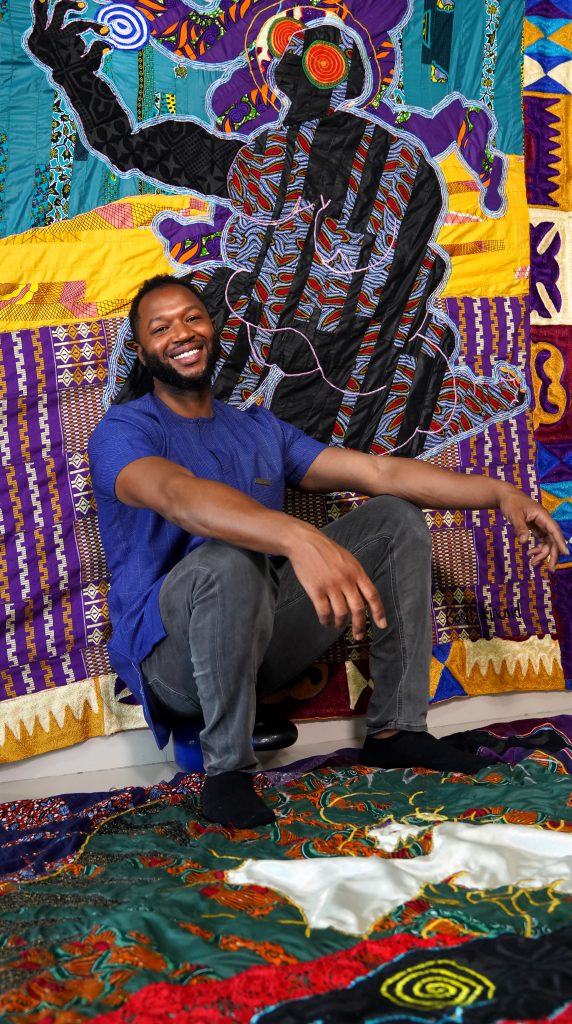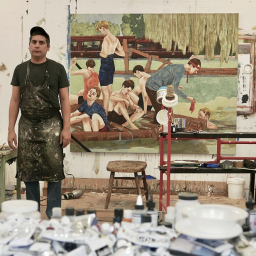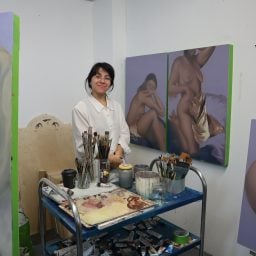Basil Kincaid (b. 1986) can trace the origins of their artistic path back to their St. Louis childhood, making their first drawings made at the tender age of three.
But, Kincaid says, it was a 2014 trip to Accra, Ghana, made possible by the non-profit Arts Connect International, that marked a real turning point in their career, inspiring the artist to begin making colorful collages from discarded calling cards collected on the streets of the city.
Today, Kincaid splits their time between Ghana and their native St. Louis and makes much of their mixed-media work—which encompasses fiber, collage, drawing, installation, and performance—from materials donated by their social media followers. This commitment to reuse is a way to reduce waste but also imbues each piece with a richer lived experience.
Currently, Kincaid’s work is on view in a current public art installation at New York’s Rockefeller Center—which includes a 125-foot mural and a monumental sculptural quilt. Coinciding with the exhibition, Artnet News spoke to the artist about their intercontinental practice and day-to-day life in the studio.
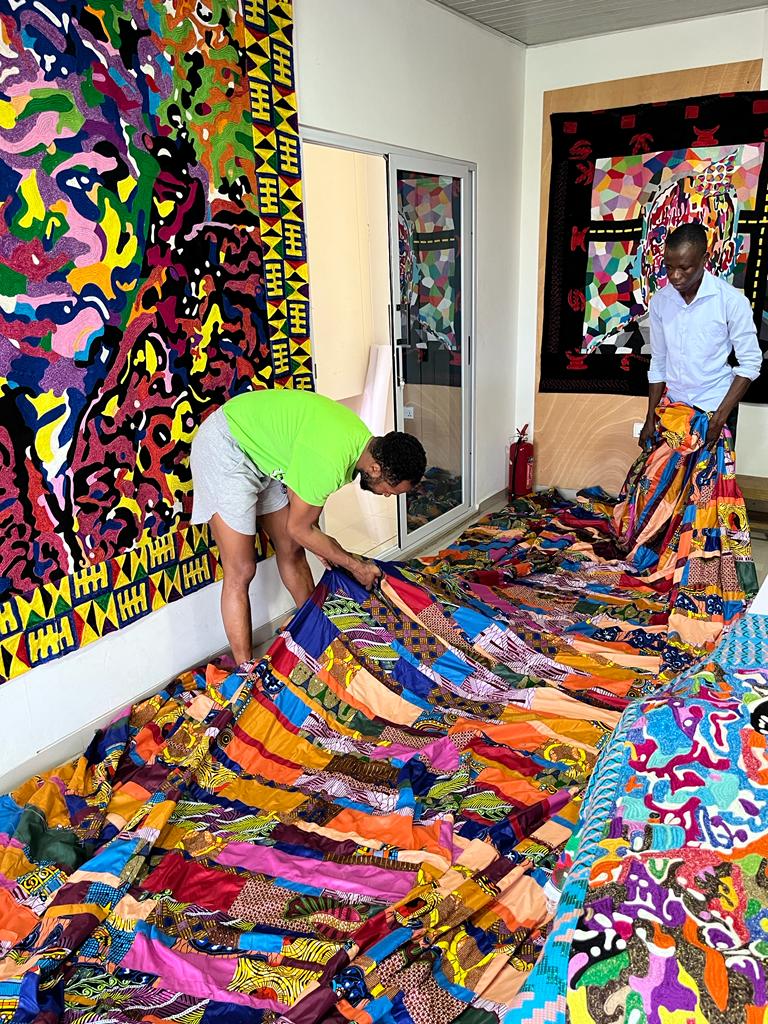
Basil Kincaid’s studio. Photo courtesy of the artist.
Tell us about your studio. Where is it, how did you find it, what kind of space is it,
etc.?
I have a drawing studio in St. Louis and a fiber laboratory in Klagon, Ghana. The home studio is what I imagined my ideal room as a kid: with books and papers and drawings and supplies all over. The Ghana studio is pure open space that I’ve divided into dedicated stations for various parts of my workflow. We have an embroidery room, a room where we focus on the patchwork for the quilts, and a room that’s primarily for reflecting on and photographing works—but we all gather in there to hand-sew.
What is the first thing you do when you walk into your studio (after turning on the lights)?
First thing I do when I walk into the studio is take off my shoes. Then I say a little prayer. Rhoda, my Ghana studio lead, will sing some songs and pray even more. I’ll unpack my backpack and take out my notebook, computer, camera, SD cards, and adapters. I always bring a toy to the studio, like a little totem to keep me company throughout the day. I have blue dice that has a quilt on each side instead of numbers; I have a little tiger that I’ve had since college…
Then I’ll arrange myself and take a deep breath. I look at the to-do list I made the night before and dive in.
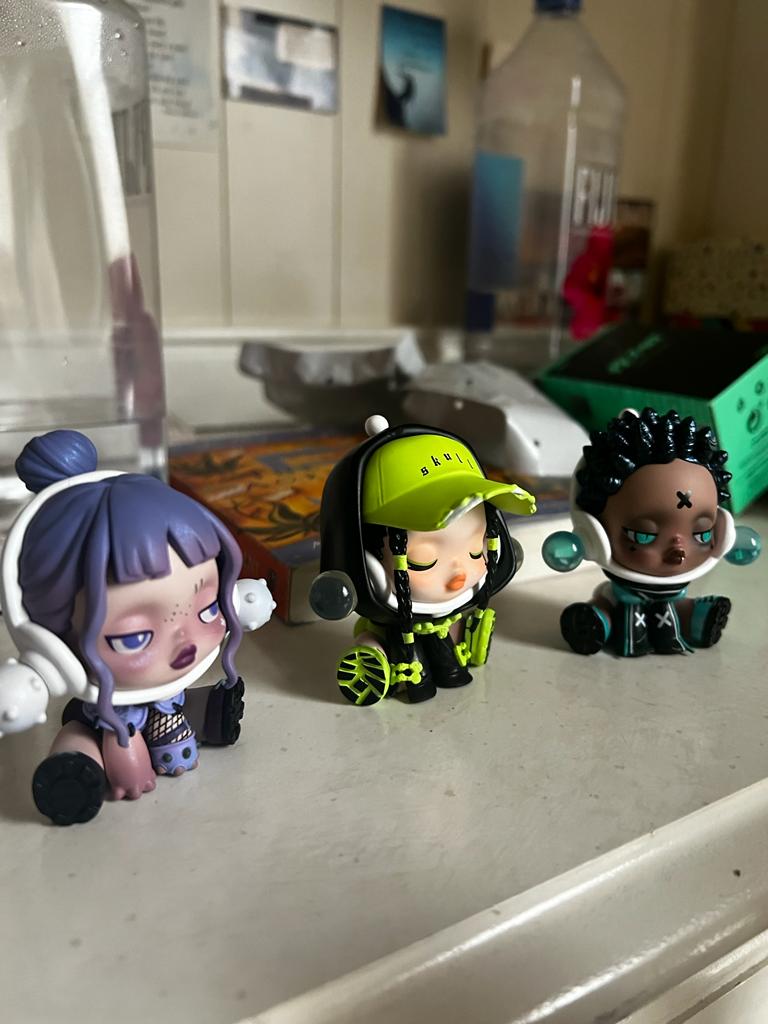
Toys in Basil Kincaid’s studio. Photo courtesy of the artist.
How many studio assistants or other team members do you have working with you, and what do they do?
I have eight team members between the States and Ghana. Julia and Rhoda are like the captains of the team; they manage different departments of the practice. Julia is kind of like up in the sky with me processing ideas and developing our written language around the work. Julia is also the lead on communications and logistics within the U.S. and Europe.
Rhoda manages the network of production assistants, she operates the Ghana studio and does logistics for the West African sector of my practice. She manages the needs of the production team and we brainstorm together; she’s solutions-oriented and a master with the hand-sewing.
The rest of the team is spread between embroidery and general sewing. I have a couple of generational masters of embroidery whose fathers and grandfathers were also masters of embroidery. I love working with them because I am also mastering my generational family art and my practice has to do with emboldening and bridging the gap between Black American, Indigenous American, and West African generational cultural practices. I learn a lot by just being with my team.
The general sewing crew does hand sewing and machine sewing. They focus on processing the fabrics that we collect and then piecing them together, following my frameworks for rhythmic abstraction or following patterns that I set forth to be employed on certain materials.
I like for each person to do what they’re best at.
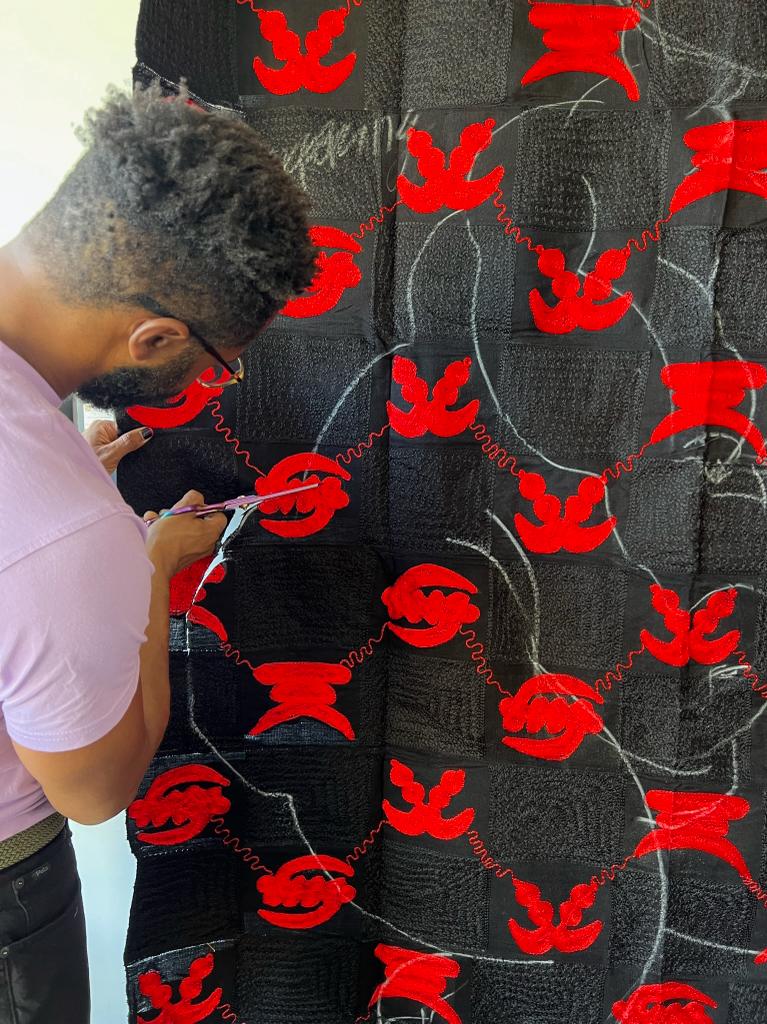
Basil Kincaid drawing. Photo courtesy of the artist.
What are you working on right now?
I just installed an exhibition for the Art Production Fund’s Art in Focus program at Rockefeller Center in New York. This project almost feels like a direct extension of the installation I did with the Art Production Fund at Frieze LA this past February where I wrapped a small two-person airplane in massive quilts made from material collected across St. Louis and Ghana. I used that same quilt in the environments I created in a few of Rockefeller Center’s vitrines. To see the fabric continue to travel and collect memorial content has been such a rewarding part of these experiences.
Otherwise, I’m working on resting and recharging. I’m working on nurturing my soul and having valuable life experiences that impact the work. I’m working on being still and breathing with my full lungs. I’m working on connecting with trees and feeling the grass on my skin. I’m working on long naps where I remember my dreams. I’m working on being a better friend and eventually a really great lover and one-day partner. My primary pursuit at all times is to expand my freedom and the freedom of subjugated people. But I have to start with myself and develop what it means to me to live freely with purpose in a way that’s positive to everyone and every space I interact with.

Basil Kincaid’s studio. Photo courtesy of the artist.
Show us a few different iPhone photos of a work in progress in a way that you think will provide insight into your process.
Drawing is embedded in the making of the quilts. I often scale up elements of drawings I’ve done on paper, iterating the figures freehand in chalk on fabric. Once drawn, I cut them out and transfer them over to a background or “canvas” of quilt.
The column strip quilts are foundational to the process and legacy of quilt-making. They serve as the primary layer for additional layers to latch onto and invoke the tradition of Gee’s Bend. This photo calls upon that anchoring element. Rhoda is on the right.
Once I have cutouts of the figures in the composition, I lay out the full vision. I join the layers before sewing them together to make sure the whole picture translates at scale—then the piece moves on to hand sewing and embroidery.
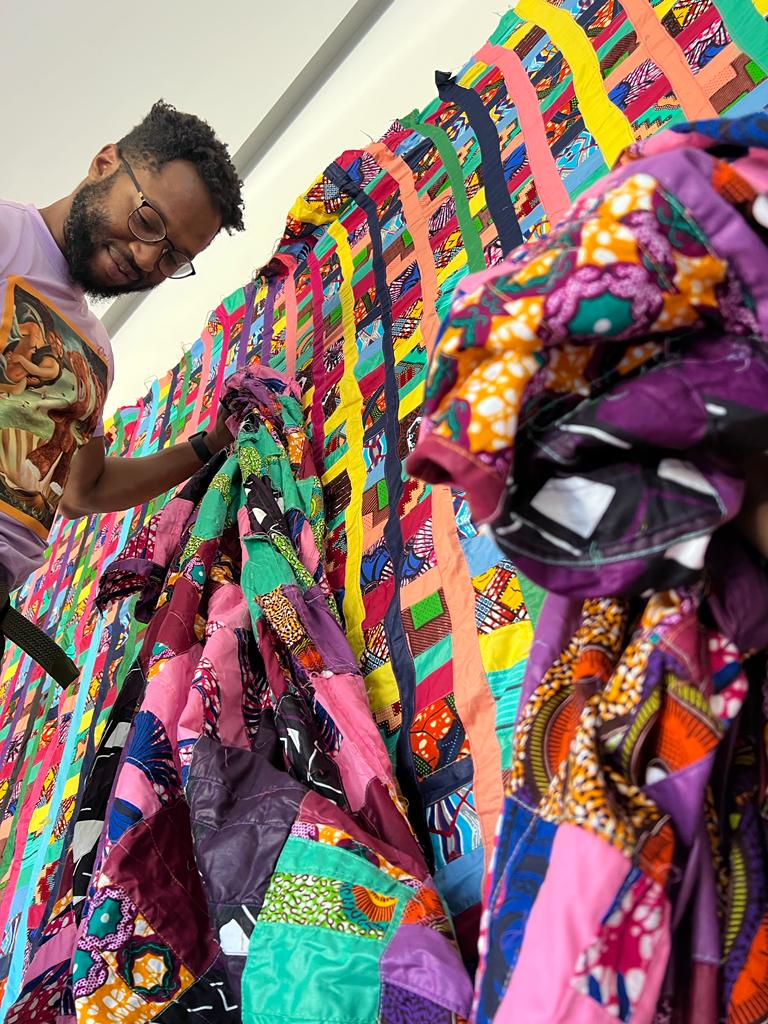
Basil Kincaid’s studio. Photo courtesy of the artist.
How many hours do you typically spend in the studio, what hours do you work, and what activities fill the majority of that time?
It varies. I used to be in the studio all day every day, sometimes even sleeping in there, but I’m growing out of that. When I’m in Ghana I get up at 6:30 a.m. and work out before the sun gets hot. I built my own calisthenics gym at the mouth of the studio—I’ll do the first half of my workout and then go up to the studio around 8:30 a.m. before the rest of the team arrives at 9 a.m. If there’s a show coming up, I’ll typically work longer days. Regardless, I take little breaks as I need to keep my brain sharp. I may just swing the kettlebell or fire off some pull-ups. Whenever I end my first work block, I finish my workout, eat and nap. I typically like to get back to the studio after that for a shorter second run.
When I’m in St. Louis, I focus on drawing, planning, and envisioning/daydreaming. I also focus on resting in St. Louis, because when I’m in Ghana we typically work really diligently. Rhoda says I bring the pressure when I come. When I feel like it I’ll make some collages but I’ve been focusing more on drawings.
My St. Louis workday is a full eight-hour run. I get up at 6 a.m. Pilates class; then I eat breakfast at my friend’s restaurant and get to the gym by 7:30 a.m. for heavier lifting. I like to be home by 9 a.m., at which point I’ll put on an old movie from my VHS collection, draw for a couple of hours, and then snack and take a walk. I more or less repeat that pattern over the course of the day: draw two hours—snack—walk, for as many times as I feel like each day.
Some days I’ll prioritize the business side and instead of using a two-hour block for drawing, I’ll take two hours to do administrative work.
If I’m working half days I’ll take my notebook and a quilt out to my favorite hillside and let nature be the studio and my teacher. Just observing life and melting into the hillside. I’ll draw from life out there till I get sleepy then I’ll take a nap, hike out and head home before it’s dark. The hill I like best used to be in a sundown town area so I still observe and leave before it’s getting dark.
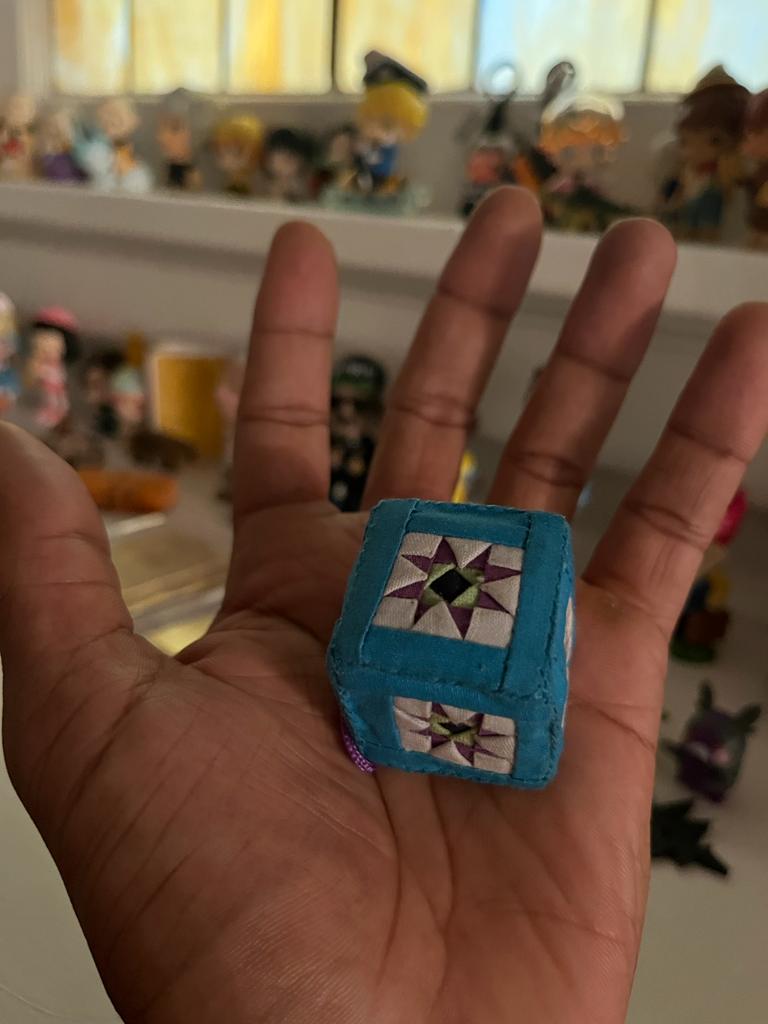
A toy die in Basil Kincaid’s. Photo courtesy of the artist.
Is there anything you like to listen to/watch/read/look at etc. while in the studio for inspiration or as ambient culture?
I think of Jack Whitten the most when I’m in the studio. The expression of our practices is very different but our method of experimentation and working almost like a scientist or a mathematician is very similar.
I also think of Eva Hesse, how she defied categorization; she was a “rule breaker” and loved material. I think about those two a lot. Jack in particular because during his career he didn’t experience financial success and he still kept pushing with the same fervor. My love for art has nothing to do with any of the outcomes. Yes, I love having a successful global practice but I had the same love before I ever sold a piece of art.
Those artists remind me to always move with love and to put curiosity at the center of my practice.
What tool or art supply do you enjoy working with the most?
My quilting practice focuses more so on materials that have an embedded emotional story or some form of lived experience. When it comes to drawing though (which informs the quilts’ compositions), crayons are one of my all-time favorite art supplies. In the past few years I’ve also grown to enjoy a variety of oil pastels; the less expensive ones offer a different texture from the higher-end ones, and I like what happens when the full spectrum is in the mix. Beyond crayons and oil pastels, I adore my tried and true micron pens. Hot-pressed papers, too. My favorite paper for drawing right now, aside from regular printer paper, is the Arches Hot Press 100% cotton paper—it’s a dream to draw on.
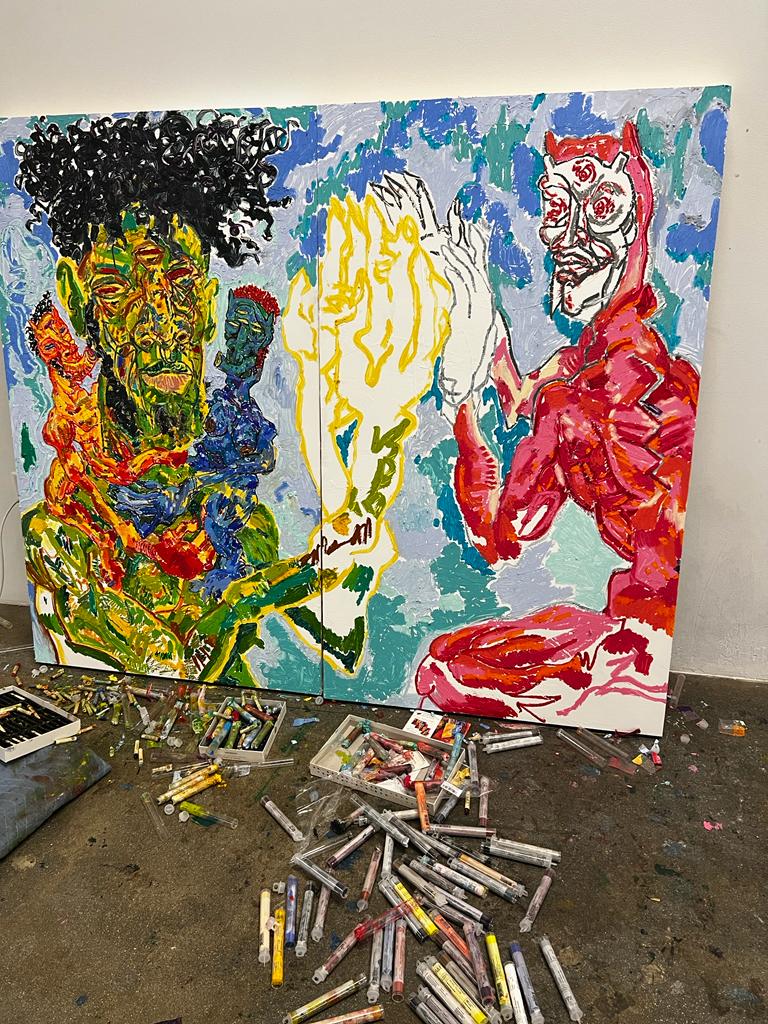
Work in Basil Kincaid’s. Photo courtesy of the artist.
What’s the last museum exhibition or gallery show you saw that really affected you and why?
The Wangechi Mutu show at the New Museum in New York. Oh my god. I was so moved by the clear development of her internal language and spiritual bearing within the work. You can tell she has that absolute trust. That ultra instinct. I love how across mediums all the work sings in her special tongue. There’s a poetry to the evolution of her practice. The way she engaged the walls and the natural light of each space. The way she transformed each floor of the museum. It’s so inspirational.
I left that show feeling invincible. I left feeling like I need to evermore embrace my maximum weirdness. Do my drawings, scrawl my thoughts, play—be me entirely. I left feeling alive, like ‘Yes! Create with all my heart.’
What’s the funniest thing that ever happened in your studio?
This isn’t so much funny as it is bizarre—but one time I was drawing and I fell asleep at the desk. When I woke up the drawing was complete. I’d finished the drawing in my sleep.
What’s the last thing you do before you leave the studio at the end of the day (besides turning off the lights)?
I always express my gratitude for the ability to make art before I leave the studio. For the spiritual bearing to be an artist. I thank all that’s thankable for everyone that supports me. I thank myself for never giving up. Often the gratitude at the end of the day will bring me to tears. I’m choking up even writing about it.
“Basil Kincaid at Rockefeller Center” is on view at Rockefeller Center, 10 Rockefeller Plaza, 30 Rockefeller Plaza, 45 Rockefeller Plaza, 50 Rockefeller Plaza, and Radio Park, New York, through August 4, 2023.
